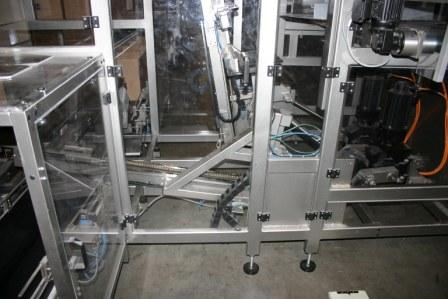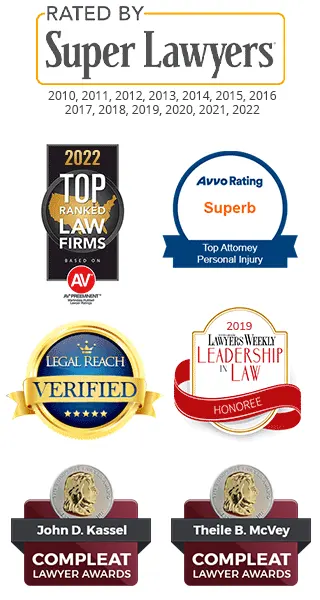

The Pasta Machine Case
We represented a worker who was severely injured on a machine designed to place containers of pasta noodles into shipping cartons. It was a large machine located in a pasta manufacturing facility. It had a lot of moving parts. The machine used a moving arm to push bags of pasta, three at a time, into a shipping container, much like a pin clearing sweep in a bowling alley.
The manufacturer of the machine recognized that the moving parts created a hazard, that is, a condition capable of causing severe personal injury. So the manufacturer encased the entire machine behind a see-through enclosure. However, the enclosure stopped nine inches above the floor, leaving a gap. The purpose of the gap was to allow for cleaning under the machine.
 Unfortunately, the pasta packing machine had a tendency to malfunction. The arm that pushed the bags of pasta into the shipping cartons tended to break. When the malfunctions occurred, bags of past would fall to the floor, often spilling their contents beneath the machine. Because this machine was used in a food manufacturing plant, management encouraged spills to be cleaned up. Through discovery, it was learned that the manufacturer was aware of the continued malfunctioning of the machine. Our client was injured when one such malfunction occurred.
Unfortunately, the pasta packing machine had a tendency to malfunction. The arm that pushed the bags of pasta into the shipping cartons tended to break. When the malfunctions occurred, bags of past would fall to the floor, often spilling their contents beneath the machine. Because this machine was used in a food manufacturing plant, management encouraged spills to be cleaned up. Through discovery, it was learned that the manufacturer was aware of the continued malfunctioning of the machine. Our client was injured when one such malfunction occurred.
Our client came to work one morning and began running the pasta machine. As in the past, the pusher arm broke. Bags of pasta noodles spilled onto the floor, with some of the bags breaking open. Our client stopped the machine and spent time fixing the pusher arm. He put the machine back into production. As with most manufacturing facilities, production is a key goal.
 The client began cleaning up the mess under the machine. He used a broom to sweep up the spilled pasta under the machine. When he thought he was done, he noticed one remaining bag that had not fallen all the way to the floor. The bag was hung up on a platform just inches above the floor, and next to the gap at the bottom of the encased machine.
The client began cleaning up the mess under the machine. He used a broom to sweep up the spilled pasta under the machine. When he thought he was done, he noticed one remaining bag that had not fallen all the way to the floor. The bag was hung up on a platform just inches above the floor, and next to the gap at the bottom of the encased machine.
Wishing to keep his worksite clean, our client reached under the enclosure to remove the bag. The bag, however, sat next to a rotating crank that moved intermittently, every 10 to 15 seconds. The client did not know about the crank, and did not realize it was a moving part. When he reached through the gap to retrieve the bag, the crank was stationary. As he grabbed the bag, the crank began to move. The crank came down on his forearm, crushing it. His arm actually stopped the machine cycle, but not before suffering very bad fractures to his ulna and radius bones, and damaging tissue, muscle, nerve and tendons. It was a near amputation. Our client ultimately underwent numerous surgical procedures in an attempt to save his arm and restore some functionality.
We filed a lawsuit against the manufacturer and the distributor of the product. Because the manufacturer was a foreign entity, we had to go through the Hague Convention to get service of legal papers on the company. Our theory of liability was that the machine design directly violated basic safety engineering standards. Specifically, ASME B15.1 2000 Safety Standard for Mechanical Power Transmission Apparatus states in paragraph 3.2.1 that “All motion hazard guards shall meet the following requirements: (a) They shall prevent entry of hands, fingers, or other parts of the body into a point of hazard by reaching through, over, under, or around the guard.” The machine enclosure was a guard that one could easily reach through or under. It had a nine inch gap at the floor. The design was in violation of the safety standard.
The machine designer was well aware that workers would attempt to clean under the machine while it was running. As a result, the designer installed interlock switches on the doors allowing access through the enclosure and into the machine. If the machine was running and the door was opened, the interlock switch would immediately shut down the machine. We advocated that the machine should have been located 36 inches behind the enclosure and the gap, so as to prevent contact if one attempted to reach in. The standard calls for guarding by location, that is locating the hazard a specified distance from an opening. The machine designer failed to do this. If locating the machine 36 inches back was not feasible, then we advocated for an interlocked guard to cover the gap. If the guard was swung open to clean under the machine, an interlock would have shut the machine down, just as with the access doors.
The manufacturer, of course, disagreed with our position and products liability case. The manufacturer argued that the cause of the injury was the worker reaching into the gap while the machine was running. The defense was to blame the worker. In most workplace accidents, severe injuries or wrongful death occurs because someone reached into a machine. Most workers probably believed what they were doing at the time was safe. They may not know all the hazards associated with the design of the machine. A worker may be wrong, but he or she should not have to go home with a disabling injury, especially when there is an economically and technologically feasible design alternative that would have eliminated or reduced the risk of injury or death. We can continue to blame workers, or we can guard the hazard and address the problem.
We resolved our case on behalf of our client.
Personal Injury Lawyers 1330 Laurel Street Columbia, SC 29201 Phone: 803-256-4242
Mailing Address
Post Office Box 1476
Columbia, South Carolina 29202
Fax: (803) 256-1952
Copyright © 2023 John D. Kassel, Attorney at Law, LLC. All rights reserved. Privacy Policy I Terms of Service | Disclaimer
This website is designed for general information only. The information should not be construed to constitute formal legal advice or the formation of a lawyer/client relationship. The results and testimonials listed on this website are specific to the facts and legal circumstances of specific cases and should not be used to form an expectation that the same results could be obtained for other clients in similar matters. This list is not a description or characterization of the quality of the firm's representation, it is not intended to compare one attorney's work to another and is in no way a guarantee of a specific result for your case.

